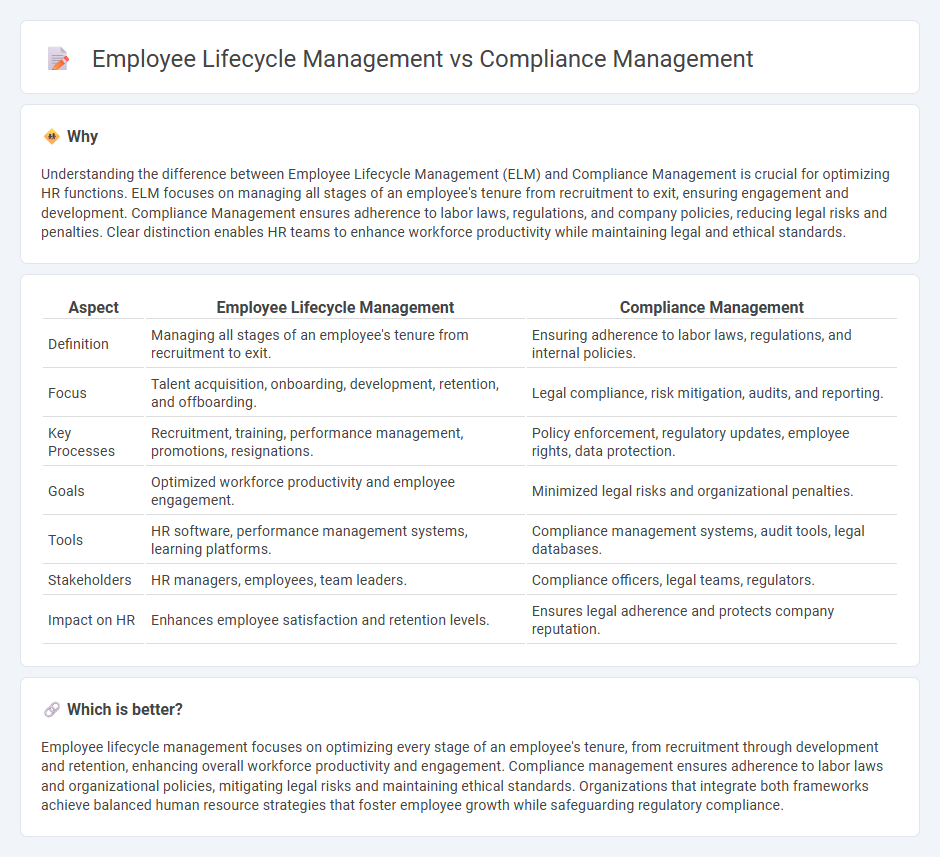
Employee lifecycle management focuses on the comprehensive process of recruiting, onboarding, developing, and offboarding employees to enhance workforce productivity and engagement. Compliance management ensures adherence to labor laws, regulations, and internal policies to mitigate legal risks and maintain organizational integrity. Explore further to understand how integrating these functions drives business success and workforce stability.
Why it is important
Understanding the difference between Employee Lifecycle Management (ELM) and Compliance Management is crucial for optimizing HR functions. ELM focuses on managing all stages of an employee's tenure from recruitment to exit, ensuring engagement and development. Compliance Management ensures adherence to labor laws, regulations, and company policies, reducing legal risks and penalties. Clear distinction enables HR teams to enhance workforce productivity while maintaining legal and ethical standards.
Comparison Table
| Aspect | Employee Lifecycle Management | Compliance Management |
|---|---|---|
| Definition | Managing all stages of an employee's tenure from recruitment to exit. | Ensuring adherence to labor laws, regulations, and internal policies. |
| Focus | Talent acquisition, onboarding, development, retention, and offboarding. | Legal compliance, risk mitigation, audits, and reporting. |
| Key Processes | Recruitment, training, performance management, promotions, resignations. | Policy enforcement, regulatory updates, employee rights, data protection. |
| Goals | Optimized workforce productivity and employee engagement. | Minimized legal risks and organizational penalties. |
| Tools | HR software, performance management systems, learning platforms. | Compliance management systems, audit tools, legal databases. |
| Stakeholders | HR managers, employees, team leaders. | Compliance officers, legal teams, regulators. |
| Impact on HR | Enhances employee satisfaction and retention levels. | Ensures legal adherence and protects company reputation. |
Which is better?
Employee lifecycle management focuses on optimizing every stage of an employee's tenure, from recruitment through development and retention, enhancing overall workforce productivity and engagement. Compliance management ensures adherence to labor laws and organizational policies, mitigating legal risks and maintaining ethical standards. Organizations that integrate both frameworks achieve balanced human resource strategies that foster employee growth while safeguarding regulatory compliance.
Connection
Employee lifecycle management and compliance management are interconnected through regulatory adherence at every stage, from recruitment to offboarding, ensuring lawful hiring, workforce data privacy, and timely training requirements. Effective employee lifecycle management integrates compliance protocols to mitigate risks like discrimination claims, labor law violations, and audit penalties. Seamless alignment of these functions supports organizational integrity, reduces legal exposure, and promotes a culture of accountability.
Key Terms
**Compliance management:**
Compliance management involves systematic monitoring and enforcing adherence to legal regulations, industry standards, and corporate policies to minimize risk and ensure organizational integrity. Key components include audit trails, policy dissemination, training programs, and incident reporting systems tailored to regulatory frameworks such as GDPR, HIPAA, and SOX. Discover how advanced compliance management solutions can safeguard your business from legal penalties and enhance operational transparency.
Regulatory Standards
Compliance management ensures that organizations adhere to regulatory standards such as GDPR, OSHA, and SOX by implementing policies, audits, and training programs that mitigate legal risks. Employee lifecycle management encompasses recruitment, onboarding, performance, and offboarding while embedding compliance checkpoints to maintain adherence with labor laws and industry regulations throughout each phase. Explore comprehensive strategies to harmonize compliance management with the employee lifecycle for seamless regulatory standard enforcement.
Auditing
Compliance management involves systematically tracking adherence to legal standards, regulations, and internal policies, ensuring organizations meet audit requirements effectively. Employee lifecycle management encompasses recruiting, onboarding, development, and offboarding processes with audit trails highlighting employee compliance and performance at each stage. Explore how integrating both approaches enhances audit efficiency and organizational accountability.
Source and External Links
Compliance Management: Process, Regulations, and Tools [2025] - Compliance management involves aligning organizational procedures with specific legal, regulatory, and industry standards through a process of identifying requirements, assessing current status, and developing policies and procedures to ensure adherence.
What is compliance management? - Article - SailPoint - A compliance management system is a framework of policies, procedures, controls, and continuous improvement processes that help organizations systematically manage their legal and regulatory obligations while mitigating risks and improving operational consistency.
What is a Compliance Management System? - IBM - A compliance management system integrates policies, employee training, risk assessments, reporting mechanisms, and corrective action steps within a compliance program to ensure consistent adherence to regulations and internal standards, supported by senior management oversight.
 dowidth.com
dowidth.com